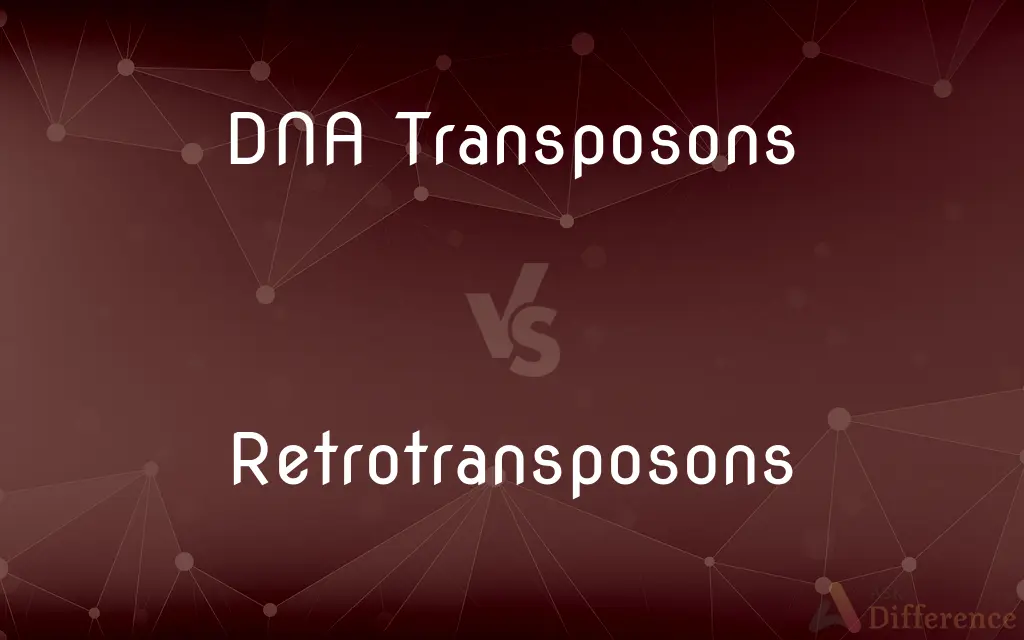DNA Transposons vs. Retrotransposons — What's the Difference?
By Tayyaba Rehman & Urooj Arif — Published on February 17, 2024
DNA transposons move directly within the genome using a "cut and paste" mechanism. Retrotransposons move via an RNA intermediate, employing a "copy and paste" mechanism through reverse transcription.

Difference Between DNA Transposons and Retrotransposons
Table of Contents
ADVERTISEMENT
Key Differences
DNA transposons and retrotransposons represent two distinct classes of mobile genetic elements capable of relocating within a genome. DNA transposons move within the genome through a mechanism that involves excision from one genomic location and integration into another, often described as "cut and paste." This process is mediated by transposase enzymes that recognize terminal repeat sequences in the DNA transposon's structure.
Retrotransposons, in contrast, move through a "copy and paste" mechanism. They are transcribed into RNA, which is then reverse-transcribed into DNA by the enzyme reverse transcriptase. This newly synthesized DNA is integrated into a new location in the genome, resulting in the duplication of the retrotransposon. Retrotransposons are further divided into two main types: LTR (long terminal repeats) retrotransposons and non-LTR retrotransposons, including LINEs (Long Interspersed Nuclear Elements) and SINEs (Short Interspersed Nuclear Elements).
While DNA transposons directly move from one place to another within the genome, retrotransposons increase the copy number within the genome each time they transpose, potentially contributing to genomic expansion. DNA transposons are less common in human genomes, whereas retrotransposons make up a significant portion of the human genome.
The transposition activity of DNA transposons is relatively straightforward and does not involve an RNA intermediate, whereas retrotransposons' transposition includes transcription into RNA, reverse transcription into DNA, and then integration. This fundamental difference in their mechanisms of movement reflects their distinct impacts on genome structure and evolution.
In summary, DNA transposons and retrotransposons are key players in genomic diversity and evolution, with DNA transposons employing a simpler transposition process compared to the more complex and copy number-increasing process of retrotransposons.
ADVERTISEMENT
Comparison Chart
Mechanism
"Cut and paste"
"Copy and paste" through reverse transcription
Intermediate
Direct DNA movement
RNA intermediate
Enzyme Required
Transposase
Reverse transcriptase
Impact on Genome
Moves without increasing copy number
Increases copy number, potentially expanding the genome
Presence in Human Genome
Less common
Make up a significant portion
Compare with Definitions
DNA Transposons
Can cause mutations when inserting into genes.
A DNA transposon insertion disrupted the gene, leading to a loss of function.
Retrotransposons
Retrotransposons transpose through an RNA intermediate.
LINE-1 is an autonomous retrotransposon that can mobilize in the genome.
DNA Transposons
DNA transposons are genetic elements that move via a cut-and-paste mechanism.
The mariner element is a type of DNA transposon found in multiple species.
Retrotransposons
Can affect gene expression and genome structure.
Retrotransposon insertions near genes can alter their expression patterns.
DNA Transposons
Have terminal inverted repeats.
The terminal inverted repeats of DNA transposons are crucial for their recognition by transposase.
Retrotransposons
Require reverse transcriptase for movement.
The enzyme reverse transcriptase is essential for retrotransposon replication.
DNA Transposons
Require transposase for movement.
DNA transposons utilize transposase to excise and reintegrate into the genome.
Retrotransposons
Include elements like LINEs and SINEs.
Alu elements, a type of SINE, are the most abundant retrotransposons in the human genome.
DNA Transposons
Do not replicate upon transposition.
Unlike retrotransposons, DNA transposons don't increase their copy number during transposition.
Retrotransposons
Increase genomic content upon transposition.
Retrotransposons have significantly contributed to human genomic diversity.
Retrotransposons
A transposon copied from RNA with the use of reverse transcriptase.
Common Curiosities
Can DNA transposons increase their copy number in the genome?
No, they move without replicating themselves, maintaining their copy number.
Do DNA transposons need reverse transcriptase?
No, they require transposase for their movement.
Can retrotransposons cause mutations?
Yes, their insertion can disrupt genes or regulatory regions, potentially causing mutations.
How do retrotransposons move?
They use a copy-and-paste mechanism involving reverse transcription from an RNA intermediate.
What is the difference in the transposition process between the two?
DNA transposons directly transpose DNA, whereas retrotransposons transpose via an RNA intermediate.
Can DNA transposons be used in genetic research?
Yes, they are used as tools in genetic engineering and functional genomics studies.
What is a DNA transposon?
A genetic element that moves within the genome using a cut-and-paste mechanism.
Why are retrotransposons significant in the human genome?
They constitute a large portion of the human genome and play roles in genomic diversity and evolution.
How can retrotransposons affect an organism?
They can influence gene expression, contribute to genetic diseases, and drive genomic evolution.
Are DNA transposons active in all organisms?
Their activity varies; many are inactive in humans but can be active in other organisms.
How do DNA transposons affect genome size?
They generally do not affect genome size since they do not replicate upon transposition.
What role do retrotransposons play in evolution?
They contribute to genetic diversity and have been a significant force in shaping genomes over evolutionary time.
How is the activity of these elements regulated?
Both types of elements are regulated by the host genome through mechanisms like DNA methylation and histone modification.
Can the movement of these elements be beneficial?
Yes, in some cases, their movement can create genetic variation that may be advantageous under certain environmental conditions.
Are all retrotransposons the same?
No, there are different types, including LTR retrotransposons, LINEs, and SINEs, with varying mechanisms and effects.
Share Your Discovery

Previous Comparison
De Broglie vs. Heisenberg Uncertainty Principle
Next Comparison
Thalys vs. TGVAuthor Spotlight
Written by
Tayyaba RehmanTayyaba Rehman is a distinguished writer, currently serving as a primary contributor to askdifference.com. As a researcher in semantics and etymology, Tayyaba's passion for the complexity of languages and their distinctions has found a perfect home on the platform. Tayyaba delves into the intricacies of language, distinguishing between commonly confused words and phrases, thereby providing clarity for readers worldwide.
Co-written by
Urooj ArifUrooj is a skilled content writer at Ask Difference, known for her exceptional ability to simplify complex topics into engaging and informative content. With a passion for research and a flair for clear, concise writing, she consistently delivers articles that resonate with our diverse audience.














































